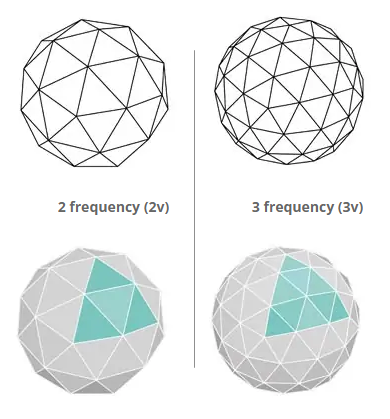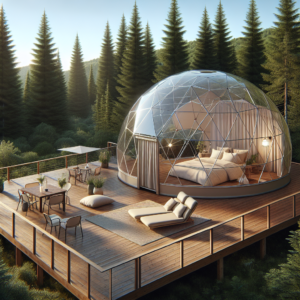
2V and 3V illustration from www.lotusdomes.co.uk
Key Takeaways
-
Geodesic domes are a sustainable architectural choice, offering strength and energy efficiency.
-
2V geodesic domes are simpler, suitable for small-scale projects, and easier to construct.
-
3V geodesic domes are more complex but cover larger areas and provide more stability.
-
Both types of domes have unique advantages, depending on the intended use and size of the project.
-
Choosing the right geodesic dome involves considering factors like cost, longevity, and environmental impact.
Understanding Geodesic Domes
Imagine a sphere made up of numerous triangles. That’s essentially what a geodesic dome is. These domes are designed to mimic the natural strength of arches and spheres, combined with the rigidity of triangles. This unique design not only looks cool but also makes them incredibly strong and able to withstand severe weather like hurricanes and earthquakes.
2V vs 3V Structures: A Primer
So, what’s the difference between 2V and 3V geodesic domes? It’s all about the triangles. A 2V dome has fewer triangles, making it a bit simpler in design. On the other hand, a 3V dome has more triangles, which makes it more complex but also allows it to cover a larger area. The “V” stands for “frequency,” and it’s a way to describe how many times the basic triangular pattern is repeated.
Recap Table: Geodesic Dome Comparison – 2V vs. 3V Structures
This table provides a concise overview of the differences between 2V and 3V geodesic domes, highlighting key aspects such as design complexity, material efficiency, cost, longevity, and environmental impact.
| Aspect | 2V Geodesic Domes | 3V Geodesic Domes |
| Design Complexity | Simpler design with fewer triangles, making construction easier and more straightforward. | More complex design with additional triangles, offering greater strength and stability, suitable for larger areas. |
| Material Efficiency | Uses fewer materials, leading to more economical construction. | Requires more materials but provides a greater span and durability due to the intricate triangle network. |
| Cost | Generally lower costs in construction and materials due to simplicity in design. | May be more expensive upfront due to complexity and increased material quantity, but offers durability and longevity. |
| Longevity | Both types are durable, but the added stability of 3V structures may provide a longer lifespan, especially in harsh environments. | The robustness of 3V domes enhances longevity, making them suitable for enduring various conditions over time. |
| Environmental Impact | 2V domes have a smaller footprint and may use less energy for heating and cooling, while 3V domes provide more insulation space, potentially offering greater energy efficiency in larger structures. | Consider the long-term energy savings; a well-insulated 3V dome could significantly reduce your carbon footprint over time despite requiring more materials initially. |
| Considerations | Perfect for Smaller Spaces Ease and Speed of Construction Budget-Friendly Accessible Introduction to Sustainable Architecture | Strength and Stability Covering Larger Areas Versatility in Design Flexibility in Functionality |
Innovative Uses of 2V Geodesic Domes

EKODOME® PRO LUNA 16 FT / 5M from www.ekodome.com
2V geodesic domes are perfect for smaller spaces. They’re commonly used in backyard projects, greenhouses, and even as eco-friendly living spaces. Their simplicity doesn’t just stop at design; it extends to construction as well. With fewer components, 2V domes can be a weekend project for those who love DIY.
Advantages of 2V Geodesic Domes
-
Easier to construct with fewer components.
-
Ideal for small-scale projects and personal use.
-
Cost-effective due to simplicity in design.
2V domes are a fantastic starting point for those new to geodesic dome building. Their straightforward design ensures that even without extensive construction experience, you can create a functional and sustainable structure.
Real-World Applications
Let’s take a real-world example. Imagine a cozy geodesic dome nestled in a garden, serving as a tranquil retreat or a vibrant greenhouse. This is where a 2V structure shines. Its simplicity blends perfectly with nature, and it’s just the right size to be a personal sanctuary without overwhelming the landscape.
Most importantly, when you choose a geodesic dome, you’re not just picking a cool design. You’re making a statement about sustainability and resilience. But that’s just the beginning. In the next part of this article, we’ll explore the versatility of 3V domes and how they compare to their 2V counterparts. Stay tuned as we unfold the layers of these fascinating structures.
3V Geodesic Domes for Grand Scale Applications

EKODOME® TERRA 22 FT / 7M from www.ekodome.com
Why Choose a 3V Structure?
If your project is grander in scale, a 3V geodesic dome might be just what you need. These domes have more triangles, which translates to a more robust and stable structure. This makes them suitable for larger community spaces, event venues, or even eco-friendly commercial buildings. Because they can span wider areas without internal supports, they’re incredibly versatile and can be adapted for various uses.
Diverse Applications for Larger Spaces
Consider a community center built as a 3V geodesic dome, offering a large open space for events, sports, and social gatherings. Or picture a spacious dome greenhouse, fostering a sustainable, controlled environment for year-round farming. These are just a couple of examples of how 3V structures can serve the needs of larger spaces and communities, providing not just a building, but a centerpiece for eco-conscious living.
Comparative Analysis: Weighing 2V Against 3V Structures
When deciding between a 2V and a 3V geodesic dome, it’s important to weigh the pros and cons of each. The choice you make should be based on your specific needs, the size of the project, and the level of complexity you’re prepared to handle. Both have their place in sustainable architecture, but understanding their differences is key to making the right decision.
2V domes are simpler and more cost-effective, making them accessible for personal projects or smaller-scale applications. They are easier to build, which is a huge plus for those looking to DIY. On the flip side, 3V domes, with their increased complexity, offer greater strength and the ability to cover larger areas without support columns. This opens up possibilities for more ambitious projects that require wide, open interior spaces.
Now, let’s break down these differences into more detail to give you a clearer picture of what each structure brings to the table. For a deeper understanding, consider the pros and cons of geodesic dome homes which can help illustrate the unique aspects of 2V and 3V geodesic domes.
-
Design Complexity: 2V domes are simpler with fewer triangles, while 3V domes have a more complex network of triangles for added strength and stability.
-
Material Efficiency: 2V domes use fewer materials and are therefore more economical, whereas 3V domes require more materials but offer a greater span and durability.
-
Cost: The simplicity of 2V domes often leads to lower costs in construction and materials. In contrast, 3V domes may be more expensive due to their complexity and the larger quantity of materials needed.
-
Longevity: Both 2V and 3V domes are durable, but the added stability of a 3V structure may provide a longer lifespan, especially in harsh environments.
Considering these points, you should evaluate what’s most important for your project. Is it the budget, the size, the durability, or perhaps a combination of these factors?
Design Complexity and Material Efficiency
Building a geodesic dome is like piecing together a giant 3D puzzle. In a 2V dome, with fewer pieces, the puzzle is relatively straightforward. This means you’ll likely spend less time and money on construction. However, the simplicity of a 2V design does limit the size of the dome.
On the other hand, a 3V dome, with its intricate pattern of triangles, is more complex and requires careful planning and more materials. This complexity is not just for show; it translates into a structure that can endure more weight and span greater distances without internal support.
Cost Implications and Longevity
It usually costs less to build a 2V dome because it’s smaller and requires fewer materials. If you’re on a tight budget or looking for a compact living space, this could be a deciding factor. In contrast, 3V domes are generally more expensive, but they’re also an investment in longevity. The extra cost upfront could save you money in the long run, thanks to the dome’s durability and potential energy savings.
Environmental Impact Comparison
Besides that, there’s the environmental impact to consider. Geodesic domes are eco-friendly by nature, but the amount of materials used and the energy efficiency of the structure can vary between 2V and 3V designs. 2V domes, with their smaller footprint, may use less energy to heat and cool, while 3V domes provide more insulation space, which could be more efficient in larger structures.
Therefore, when considering the environmental impact, think about the long-term energy savings. A well-insulated 3V dome could reduce your carbon footprint significantly over time, even if it requires more materials to build.
Optimizing Your Choice: Selecting Between 2V and 3V Domes
Now that we’ve compared 2V and 3V geodesic domes, how do you decide which is right for you? It comes down to the scope of your project and what you value most. Let’s look at some scenarios and considerations for each type of dome to help you make the best choice for your sustainable building venture.
When to Opt for 2V Domes: Scenarios and Considerations
If you’re planning a personal project like a backyard studio, a playroom, or a garden greenhouse, a 2V dome is likely your best bet. These domes are:
- Ideal for intimate projects with limited footprint requirements.
- Streamlined assembly for rapid realization of your vision.
- Cost-effective option without compromising quality or durability.
- A gentle initiation into eco-conscious building practices.
Most importantly, they can be a great way to dip your toes into the world of sustainable architecture without feeling overwhelmed by the complexity of construction.
Choosing 3V Domes: Scenarios and Considerations
On the flip side, if you’re envisioning a larger communal space, like a public greenhouse, an educational facility, or an event dome, then a 3V structure will serve you better. Its strength and ability to cover larger areas make it ideal for these types of projects. he 3V dome offers several advantages in such scenarios:
- Unparalleled structural integrity for safety and endurance.
- Seamless, column-free expanses maximizing usable space.
- Architectural dynamism for aesthetic innovation.
- Adaptive spaces tailored to diverse needs and activities.
Therefore, when making your choice, consider the long-term benefits alongside the immediate needs. Whether you opt for a 2V or 3V dome, you’re taking a step towards sustainable living, and that’s a move in the right direction.
FAQ
Can geodesic domes withstand extreme weather?
One of the most remarkable features of geodesic domes is their ability to withstand extreme weather conditions. The interlocking triangles create a self-supporting structure that distributes stress evenly throughout the dome. This makes them exceptionally resistant to high winds, heavy snowfall, and even seismic activity. In fact, their aerodynamic shape allows wind to flow over and around them, reducing the risk of damage during storms.
-
Geodesic domes have withstood winds of over 200 miles per hour.
-
They can support heavy snow loads, making them suitable for areas with harsh winters.
-
Their shape and structure allow them to survive earthquakes better than traditional buildings.
Therefore, if you live in an area prone to natural disasters, a geodesic dome could be a wise choice for its resilience and durability.
What is the lifespan of a geodesic dome?
The lifespan of a geodesic dome can be quite impressive. With proper maintenance, a geodesic dome can last for several decades. The exact lifespan will depend on the materials used, the environmental conditions, and how well the dome is maintained. Aluminum and steel domes, for instance, are known for their longevity and can last for over 50 years.
Keep in mind that the dome’s covering material also plays a crucial role in its longevity. High-quality, UV-resistant covers can extend the life of your dome, ensuring it remains a sustainable and lasting structure.
Are geodesic domes costlier than traditional buildings?
On average, geodesic domes can be more cost-effective than traditional buildings. The cost savings come from the dome’s efficient use of materials and energy. Here’s a quick comparison:
When it comes to construction, geodesic domes often require less material per square foot than traditional buildings. This is because their spherical shape provides the maximum amount of space with the minimum amount of surface area. Additionally, the energy efficiency of domes can lead to long-term savings on heating and cooling costs.
However, it’s important to note that the initial cost may be higher due to the specialized design and construction techniques required. But, when considering the dome’s durability, energy savings, and potential for lower maintenance costs, it can be a more economical choice in the long run.
Can I build a geodesic dome as a DIY Project?
Yes, you can build a geodesic dome as a DIY project, especially if you’re opting for a 2V structure. These domes are more straightforward and can often be constructed with basic building skills. Many companies offer geodesic dome kits that come with pre-cut and pre-drilled parts, making the assembly process much easier for the average DIY enthusiast.
Before embarking on a DIY geodesic dome project, it’s important to have a clear plan, the right tools, and a basic understanding of the construction process. It’s also crucial to check with your local building authorities to ensure that your dome meets all required codes and regulations.
What are the insulation options for geodesic domes?
Insulation is key for maintaining a comfortable temperature inside a geodesic dome and for maximizing energy efficiency. There are several insulation options available for domes.




